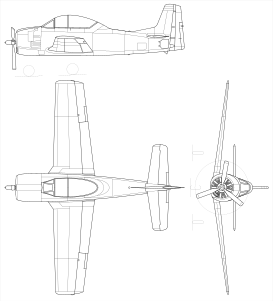North American T-28 Trojan
| T-28 Trojan | |
|---|---|
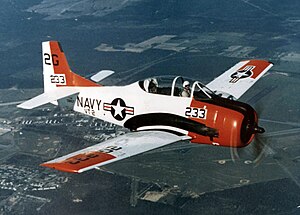 A US Navy T-28B in 1973 | |
| General information | |
| Type | Trainer aircraft Light attack |
| Manufacturer | North American Aviation |
| Primary users | United States Air Force |
| Number built | 1,948 |
| History | |
| Manufactured | 1950–1957 |
| First flight | 24 September 1949 |
| Retired | 1994Philippine Air Force[1] |
| Developed from | North American XSN2J |
| Developed into | AIDC T-CH-1 |
TheNorth American Aviation T-28 Trojanis aradial-enginemilitarytrainer aircraftmanufactured byNorth American Aviationand used by theUnited States Air ForceandUnited States Navybeginning in the 1950s. Besides its use as a trainer, the T-28 was successfully employed as acounter-insurgencyaircraft, primarily during theVietnam War.It has continued in civilian use as anaerobaticsandwarbirdperformer.
Design and development
[edit]On 24 September 1949, theXT-28(company designationNA-159) was flown for the first time, designed to replace theT-6 Texan.The T-28A arrived at theAir Proving Ground,Eglin Air Force Base,Florida, in mid-June 1950, for suitability tests as an advanced trainer by the 3200th Fighter Test Squadron, with consideration given to its transition, instrument, and gunnery capabilities.[2]Found satisfactory, a contract was issued and between 1950 and 1957, a total of 1,948 were built.
Following the T-28's withdrawal from U.S. military service, a number were remanufactured byHamilton Aircraftinto two versions called theNomair.The first refurbished machines, designatedT-28R-1were similar to the standard T-28s they were adapted from, and were supplied to theBrazilian Navy.Later, a more ambitious conversion was undertaken as theT-28R-2,which transformed the two-seat tandem aircraft into a five-seat cabin monoplane for general aviation use. Other civil conversions of ex-military T-28As were undertaken byPacAeroas theNomad Mark IandNomad Mark II[3]
Operational history
[edit]
After becoming adopted as a primary trainer by the USAF, the United States Navy and Marine Corps adopted it as well. Although the Air Force phased out the aircraft from primary pilot training by the early 1960s, continuing use only for limited training of special operations aircrews and for primary training of select foreign military personnel, the aircraft continued to be used as a primary trainer by the Navy (and by default, the Marine Corps and Coast Guard) well into the early 1980s.
The largest single concentration of this aircraft was employed by the U.S. Navy atNaval Air Station Whiting FieldinMilton, Florida,in the training of student naval aviators. The T-28's service career in the U.S. military ended with the completion of the phase-in of theT-34Cturboprop trainer. The last U.S. Navy training squadron to fly the T-28 wasVT-27"Boomers", based atNaval Air Station Corpus Christi,Texas, flying the last T-28 training flight in early 1984. The last T-28 in the Training Command,BuNo137796, departed for Naval District Washington on 14 March 1984 to be displayed permanently atNaval Support Facility Anacostia,D.C.[4]
Vietnam War combat
[edit]
In 1963, aRoyal Lao Air ForceT-28 piloted by Lieutenant Chert Saibory, a Thai national, defected toNorth Vietnam.Saibory was immediately imprisoned and his aircraft was impounded. Within six months the T-28 was refurbished and commissioned into theNorth Vietnamese Air Forceas its first fighter aircraft.[5]Lt. Saibory later trained NVAF pilot Nguyen Van Ba in the operation of the T-28, where Nguyen flew the T-28 in its first successful interception against an SVNAFC-123 Provideron 15 February, 1964, earning the NVAF its first-ever aerial victory.[6]
T-28s were supplied to theRepublic of Vietnam Air Force(RVNAF) in support ofARVNground operations, seeing extensive service during theVietnam Warin RVNAF hands, as well as theSecret WarinLaos.A T-28 Trojan was the first US fixed wing attack aircraft (non-transport type) lost in South Vietnam, during the Vietnam War. Capt. Robert L. Simpson, USAF, Detachment 2A,1st Air Commando Group,and Lt. Hoa, RVNAF, were shot down by ground fire on August 28, 1962 while flying close air support. Neither crewman survived. The USAF lost 23 T-28s to all causes during the war, with the last two losses occurring in 1968.[7]
Other combat uses
[edit]T-28s were used by theCIAin the formerBelgian Congoduring the 1960s.[8]
The T-28B and D were the primary ground attack aircraft ofKhmer Air ForceinCambodiaduring the war there, largely provided from the U.S. Military Equipment Delivery Team and maintained byAir America.[9]On the night of 21 January 1971, PAVN sappers managed to get close enough to destroy the majority at Pochentong airbase. Replacements were quickly shipped in. On 17 March 1973 a pilot of a T-28, said to be Capt. So Petra, a common-law husband of one of the daughters of the overthrown PrinceNorodom Sihanouk,machine gunned and bombed the palace ofLon Nolin an attempt to assassinate him, killing at least 20 and wounding 35, before defecting to Khmer Rouge held lands.[10]
France'sArmée de l'Airused locally re-manufactured Trojans,T-28S Fennec,for close support missions inAlgeria.[11]
Nicaragua replaced its fleet of 30+ ex-Swedish P-51s with T-28s in the early 1960s,[12]with more aircraft acquired in the 1970s and 1980s.[13]
ThePhilippinesutilized T-28s (colloquially known as "Tora-toras" ) during the1989 Philippine coup attempt.The aircraft were often deployed asdive bombersby rebel forces.[citation needed]
Civilian use
[edit]AeroVironmentmodified and armored a T-28A to flyweather researchforSouth Dakota School of Mines & Technology,funded by theNational Science Foundation,and operated in this capacity from 1969 to 2005.[14][15]SDSM&T was planning to replace it with another modified, but more modern, former military aircraft, specifically aFairchild Republic A-10 Thunderbolt II.[16]This plan was found to carry too many risks associated with the costly modifications required and the program was cancelled in 2018.[17]
Aerobatics and warbird display
[edit]Many retired T-28s were subsequently sold to private civil operators, and due to their reasonable operating costs are often found flying or displayed aswarbirdstoday.
Variants
[edit]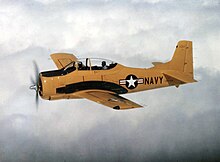



- XT-28
- Prototype; two built.
- T-28A
- U.S. Air Forceversion with an 800 hp (597 kW)Wright R-1300-1 radial engine driving a two-bladed propeller; 1,194 built.[19][20]
- T-28B
- U.S. Navyland-based trainer version with 1,425 hp (1,063 kW)Wright R-1820-86 radial engine driving a three-bladed propeller and fitted with a belly-mountedspeed brake;489 built from new and 17 converted from T-28.[21][20]
- T-28C
- U.S. Navy version, a T-28B with shortened propeller blades andtailhookfor carrier-landing training; 299 built.[20][22]
- T-28DNomad
- T-28Bs converted for the USAF in 1962 for thecounter-insurgency,reconnaissance,search and rescue,andforward air controllerroles inVietnam.Fitted with two underwing hardpoints. The laterT-28D-5had ammo pans inside the wings that could be hooked up to hardpoint-mounted gun pods for a better center of gravity and aerodynamics; 321 converted by Pacific Airmotive (Pac-Aero).
- Fairchild AT-28D
- Attackmodel of the T-28D used forClose Air Support(CAS) missions by the USAF and allied Air Forces in Southeast Asia, which were nicknamed "Tangos" by their pilots.[25]It was fitted with six underwing hardpoints and the rocket-powered Stanley Yankeeejection seat;[26]72 converted byFairchild Hiller.
- YAT-28E
- Experimental development of thecounter-insurgencyT-28D. It was powered by a 2,445 hp (1,823 kW)Lycoming YT-55L-9turboprop,and armed with two.50 in machine guns and up to 6,000 lb (2,730 kg) of weapons on 12 underwing hardpoints. Three prototypes were converted from T-28As by North American, with the first model flying on 15 February 1963. The project was canceled in 1965.[27]
- T-28S Fennec
- Ex-USAF T-28As converted in 1959 for use by the FrenchArmée de l'Air,replacing theMorane-Saulnier MS.733A.It was flown by theirEscadrilles d'Aviation Légère d'Appui(EALA; "Light Aviation Support Squadrons" ) in thecounterinsurgencyrole inNorth Africafrom 1959 to 1962. Fitted with an electrically powered sliding canopy, side-armor, a 1,200hpWright R-1820-97 supercharged radial engine (the model used in the B-17 bomber),[28]and four underwing hardpoints.[29]It is referred to as the "S" variant because its engine had asuperchargeron it; it has also been referred to as theT-28Fvariant – with the "F" standing forFrance.[citation needed]
- For fire support missions it usually carried two double-mount.50-caliber machine gun pods (with 100 rounds per gun) and two MATRAType 1226 x 68mm rocket pods.[29]It could also carry on paired hardpoints a 120 kg.[264 lb.]HEorGP"iron" bomb, aMATRAType 36136 x 37mm [1.45-inch] rocket pod, aSNEB7 x 55mm [2.16-inch] rocket pod, or a MATRAType 13single-rail, MATRAType 20orType 21double-rail, MATRAType 41quadruple-rail (2 x 2), or MATRAType 61orType 63sextuple-rail (3 x 3) SERAM T10 heavy rocket launchers.[29]Improvised napalm bombs (calledbidons spéciaux,or "special cans" ) were created by dropping gas tanks loaded with octagel-thickened fuel inside, then later igniting or detonating the spilled fuel withwhite phosphorusrockets.[29]
- Total 148 airframes bought from Pacific Airmotive (Pac Aero) and modified bySud-Aviationin France. After the war the French government offered them for sale from 1964 to 1967.[11]They sold most of them to Morocco and Argentina.[11]The Fuerza Aérea de Nicaragua (FAN) purchased four of these ex-Morocco aircraft during 1979.[citation needed]Argentina later sold some to Uruguay and Honduras.[11]
- T-28P
- T-28SFennecaircraft sold to theArgentinian Navyas carrier-borne attack aircraft. They were given shortened propeller blades and a tailhook to allow carrier landings.[30]
- T-28R Nomair
- An attempt byHamilton Aircraft CompanyofTucson, Arizonato make a civilianizedNomad III-equivalent out of refurbished ex-USAF T-28As. It had a Wright Cyclone R-1820-80 engine to make it fast and powerful, but had to lengthen the wingspan by seven feet to reduce thestall speedto below a "street-legal" 70knots.[24][31]The prototype flew for the first time in September, 1960, and the FAA Type Certificate was received on 15 February 1962.[31]At the time, the T-28-R2 was the fastest single-engined standard category aircraft available in the United States. It had been flown to a height of 38,700 ft. [11,800 m].
- T-28R-1Nomair I
- A military trainer that had atandemcockpit, dual instrumentation and flying controls, and hydraulically-actuated rearward-sliding canopy.[24][32]Six were sold in 1962 as carrier-landing trainers to the Brazilian Navy and were modified with a carrier arrestor hook. They were later transferred to the Brazilian Air Force.[31]
- T-28R-2Nomair II
- Modified to have a cramped five-seater cabin (one pilot and two rows of two passengers) that opened from theport side.[24][32]Ten aircraft were modified in all; one was sold to a high-altitude photographic company.[31]
- RT-28
- Photo reconnaissance conversion for counter-insurgency use withRoyal Lao Air Force.Number of conversions unknown.[33][34]
- AIDC T-CH-1
- A derivative of the T-28 developed byAIDCinTaiwan,theAIDC T-CH-1was powered by a 1,082 kW (1,451 hp)Avco Lycoming T53-L-701turbopropengine. Fifty aircraft were produced for theTaiwanese Air Forcebetween March 1976 and 1981. The type has since been retired.
Operators
[edit]

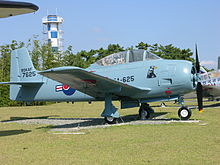
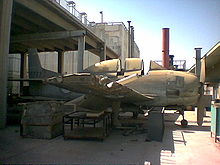



- Argentine Air Force- 34 T-28A[35][36]
- Argentine Naval Aviation.[36]65 ex-French Air ForceT-28SFennecaircraft.[37][38]Last nine transferred to Uruguayan naval aviation in 1980.[citation needed]
- Bolivian Air Forceat least six T-28Ds.[36][37][39]
- Brazilian Navy- 18 T-28C[36]
- Air Force of the Democratic Republic of the Congo- 14 T-28C, 3 T-28B, 10 T-28D[40]
- Cuban Air Force- 10 T-28As were ordered by the Batista regime but were never delivered owing to an arms embargo,[41][42]although at least one T-28 seems to have been acquired at some stage which was put on display at a museum atPlaya Girón[43][44]
- Ecuadorian Air Force- nine T-28A[36][46]
- Ethiopian Air Force- 12 T-28A and 12 T-28D[36][37][38][47]
- French Air Force- 148 T-28A airframes modified in France (1959) to make the T-28SFennecCOIN model.[38]
- Haitian Air Force- 12 ex-French Air Force[36]
- Honduran Air Force- eight former Moroccan Air ForceFennecs. One delivered, seven others impounded at Fort Lauderdale[37][38][48]
- Japanese Air Self-Defense Force- one T-28B[49][50]
- Khmer Air Forceoperated 47 T-28s in total in service.[36][37][38]
- Royal Lao Air Force- 55 T-28D[36][37][38][51]
- Mexican Air Force- 32 T-28A[36][38][52]
- Royal Moroccan Air Force- 25Fennecaircraft[36][37][38][48]
- Nicaraguan Air Force- six T-28D[36][38]
- Philippine Air Force- 12 T-28A[36][37][38][53]
- Tunisian Air Force- Fennec[36]
- United States Army[58]
- United States Air Force- 1194 T-28A, of which 360 converted to "D"[36]
- United States Navy- 489 T-28B and 299 T-28C[36]
Surviving aircraft
[edit]

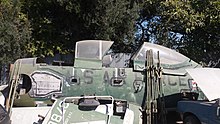
Many T-28s are on display throughout the world. In addition, a considerable number of flyable examples exist in private ownership, as the aircraft is a popular sport plane andwarbird.
Argentina
[edit]- On display
- T-28A
- S/N 174112 (ex USAF 51-3574), formerly operated by theArgentine Air Forceas E-608. Preserved at theMuseo Regional Inter Fuerzas,Estancia Santa Romana, San Luis.[62]
- C/N° 174333 (ex-USAF 51-3795), formerly operated by theArgentine Naval Aviation.Preserved at theArgentine Naval Aviation Museum.[63]
Australia
[edit]- On display
- T-28A
- 49-1583 - Australian Aviation Museum, Bankstown Airport,New South Wales, Australia.[64]
T-28 TROJAN 50-221 "LITTL JUGGS". Toowoomba Australia
https://www.gluseum.com/AU/Toowoomba/287406544649061/T-28-Trojan-50-221-%22Littl-Juggs%22
T 28B Bu 140016, Located at Jandakot Airport in Western Australia. Owned by AOG Services and registered as VH-KAN. Imported from the USA in 2014 and formerly N46984.
Philippines
[edit]- T-28A
- 109 - Philippine Air Force Museum. Colonel Jesus Villamor Air Base Pasay, Metro Manila[65]
- 7760 -Basilio Fernando Air Base. Lipa, Batangas[66]
- 612 - Villa Escudero Plantations and Resort. Tiaong, Quezon[67]
- AT-28D
- 137701 - Major Danilo Atienza Air Base, Cavite City, Cavite, Philippines.
- 114645 - Clark Air Base, Angeles City, Pampanga Philippines[68][69]
- 100310 - Edwin Andrews Air Base, Zamboanga City, Philippines.
Taiwan
[edit]- On display
- T-28A
Thailand
[edit]
- On display
- T-28A
- 49-1538 - Prachuap Khiri Khan AFB inBangkok, Thailand.[71]
- 49-1601 -Don Muang Royal Thai Air Force Base,Bangkok, Thailand.[72]
- 49-1687 -Loei Airport,Loei Province,Thailand.[73]
- 51-3480 -Udorn Royal Thai Air Force Base,Thailand.[74]
- 51-3578 - Chiang Mai AFB, Thailand.[75]
- 51-3740 -Don Muang Royal Thai Air Force Base,Bangkok, Thailand.[76]
- 153652 - National Memorial, Bangkok, Thailand.[77]
- T-28B
- 137661 -Royal Thai Air Force Museum,Bangkok, Thailand.[78]
- 138157 - Royal Thai Air Force Museum, Bangkok, Thailand.[79]
- 138284 - Royal Thai Air Force Museum, Bangkok, Thailand.[80]
- 138302 - Lopburi AFB,Thailand.[81]
United Kingdom
[edit]- On display
- T-28C
- 146289 - Norfolk & Suffolk Aviation Museum,Flixton, The Saints,United Kingdom.[82]
United States
[edit]- On display
- T-28A
- 49-1494 -National Museum of the United States Air ForceatWright-Patterson AFBinDayton, Ohio.The aircraft is painted as a typicalAir Training CommandT-28A of the mid-1950s. It was transferred to the museum in September 1965. It is on display in the museum's Cold War Gallery.[83]
- 49-1663 -Hurlburt Field,Florida.[84]
- 49-1679 -Reese AFB,Texas.[85]
- 49-1682 -Laughlin AFB,Texas.[86]
- 49-1689 -Vance AFB,Oklahoma.[87]
- 49-1695 -Randolph AFB,Texas.[88]
- 50-0300 -Dakota Territory Air Museum,Minot, North Dakota.[89]
- 51-3612 -Museum of Aviation,Robins Air Force Base,Warner Robins, Georgia.[90]
- 51-7500 -Olympic Flight Museum,Olympia, Washington.[91]
- T-28B

- 137702 -Air Force Flight Test Center Museum,Edwards AFB,California.[92]
- 137749 -Hill Aerospace Museum,Hill Air Force Base,Utah
- 137796 -Naval Air Station Anacostia,Washington, DC.[93]
- 138144 -Naval Air Station Whiting Field,Florida.[94]
- 138164 - Actively flying and performing in airshows with the Trojan Phlyers in Dallas, TX.[95]
- 138192 - Aviation Heritage Center of Wisconsin,Sheboygan Memorial Airport,Sheboygan, WI[96]
- 138247 - War Eagles Air Museum inSanta Teresa, New Mexico.[97]
- 138263 - Actively flying and based at KRLDRichland Airport,Richland, WA[98]
- 138311 -Air Heritage Aviation MuseuminBeaver Falls, Pennsylvania[99]
- 138326 -National Naval Aviation Museum,Naval Air Station Pensacola,Florida[100]
- 138339 - Owned by Skydoc 1989–present (2019)Springfield, Illinoisperforming with the Trojan Horsemen 2003-2017, and Trojan Thunder 2017–present.[101]
- 138349 -USS Hornet Air and Space Museum Alameda, California[102]
- 138353 - on a pole atMilton, Florida.[103]
- 140047 - Actively flying and performing in airshows with the Trojan Phlyers in Dallas, TX.[95]
- 140048 -National Museum of the United States Air ForceatWright-Patterson AFBinDayton, Ohio.[104]
- T-28C
- 138245 -WarBird Museum of VirginiainChesterfield, Virginia.[105]
- 140451 -Middleton FieldinEvergreen, Alabama
- 140454 -Battleship CoveinFall River, Massachusetts.[106]
- 140481 -Pima Air & Space Museumadjacent toDavis-Monthan AFBinTucson, Arizona.[107]
- 140557 -Naval Air Station Wildwood Aviation Museum,Cape May Airport,Rio Grande, New Jersey.[108]
- 140659 -Southern Museum of Flight,Birmingham, Alabama.[109]
- YAT-28E
- 0-13786 - Private collection,Port Hueneme, California.One of two surviving air-frames, currently in storage awaiting restoration.[110]
Specifications (T-28D)
[edit]Data fromEncyclopedia of World Military Aircraft[111]
General characteristics
- Crew:2
- Length:33 ft 0 in (10.06 m)
- Wingspan:40 ft 1 in (12.22 m)
- Height:12 ft 8 in (3.86 m)
- Wing area:268.0 sq ft (24.90 m2)
- Aspect ratio:6.0:1
- Empty weight:6,424 lb (2,914 kg) (equipped)
- Max takeoff weight:8,500 lb (3,856 kg)
- Powerplant:1 ×Wright R-1820-86 Cyclone 9-cylinder air-cooledradial engine,1,425 hp (1,063 kW)
Performance
- Maximum speed:343 mph (552 km/h, 298 kn) at 10,000 ft (3,000 m)
- Ferry range:1,060 mi (1,710 km, 920 nmi)
- Service ceiling:35,500 ft (10,800 m)
- Rate of climb:3,540 ft/min (18.0 m/s)
Armament
- Hardpoints:6 with a capacity of 1,200 lb (540 kg) total
See also
[edit]Related development
Aircraft of comparable role, configuration, and era
Related lists
- List of United States Navy aircraft designations (pre-1962)
- List of military aircraft of the United States
References
[edit]Notes
[edit]- ^"Historical Listings: Philippines, (PHL)."Archived2011-07-20 at theWayback MachineWorld Air Forces.Retrieved: 19 May 2011.
- ^Fort Walton, Florida, "T-28 Trainer Now at Eglin – Is Latest Word In Instructional Craft",Playground News, 22 June 1950, Vol. 5, No. 21, p. 10.
- ^abThe Illustrated Encyclopedia of Aircraft1985, p. 2678.
- ^"T-28."history.navy.mil.Retrieved: 9 July 2010.
- ^Toperczer 2001, pp. 8–9.
- ^Toperczer 2015, pp. 18–19.
- ^Hobson 2001, p. 12.
- ^Holm, Richard L."A Plane Crash, Rescue, and Recovery - A Close Call in Africa".Archived24 May 2011 at theWayback MachineCenter for the Study of Intelligence, Historical Perspectives,Washington, D.C., Winter 1999-2000.
- ^Leeker, Dr Joe F."Khmer Air Force T-28s(maintained under the supervision of Air America’s LMAT, Phnom Penh)"
- ^New York Times."20 DIE IN BOMBING AiMED AT LON NOL".
- ^abcdGanivet, Jean-Luc."T-28 Fennec History."fennec.pfiquet.Retrieved: 31 December 2013.
- ^Hagedorn 1993, p. 41
- ^Hagedorn 1993, pp. 42–43
- ^Godfrey, Joe."Charlie Summers"AVweb,16 April 2003. Retrieved: 22 July 2012.
- ^"T-28 Instrumented Research Aircraft"Archived1 January 2012 at theWayback MachineSouth Dakota School of Mines & Technology.Retrieved: 22 July 2012.
- ^"Next-generation Storm-penetrating Aircraft"(PDF).South Dakota School of Mines and Technology. Archived fromthe original(PDF)on 12 November 2013.Retrieved14 December2013.
- ^Rogoway, Tyler."The Storm Chasing A-10 Thunderhog Program Is Officially Dead, Jet To Be Returned To USAF".The Drive.Retrieved13 October2018.
- ^See German WikipediaFlugplatz Albstadt-Degerfeld
- ^Ginter 1981, p. 6
- ^abcDarke 2013, p. 147
- ^Ginter 1981, p. 27
- ^Ginter 1981, p. 53
- ^Sweeney, Richard L. "New Role for Nomad."Flying Magazine,December 1961.
- ^abcdConcannon, Milt."The Lost (and last) Nomad."Archived2014-01-01 at theWayback Machinecourtesyaircraft.com.Retrieved: December 31, 2013.
- ^Trichter, J. Gary (12 August 2016)."The Poor Man's P-51: The T-28 Trojan".Retrieved12 July2019.
- ^"The Ejection Site: Stanley YANKEE Extraction System".www.ejectionsite.com.
- ^TateAir EnthusiastMay/June 1999, pp. 58–59.
- ^"Warbirds of New Smyrna."angelfire.com,p. 44. Retrieved: 31 December 2013.
- ^abcdRenaud, Patrick-Charles."Aerostories (Algérie (1954-1962): T-28 Fennec: des ailes pour un renard."aerostories,2002. Retrieved: 31 December 2013.
- ^North American T-28 Trojan/Fennec in Argentina
- ^abcd"Hamilton T-28-R2 Nomair (N9106Z)".Ron Dupas Collection,No. 1040, August 1970. Retrieved: 31 December 2013.
- ^abFlying Magazine,April 1962, p. 3.
- ^Troung, Albert Grandolini and Tom Cooper."Laos, 1948-1989; Part 1."Indochina Database,13 November 2003. Retrieved: 17 April 2012.
- ^Troung, Albert Grandolini and Tom Cooper."Laos, 1948-1989; Part 2."Indochina Database,13 November 2003. Retrieved: 17 April 2012.
- ^Ay, Carlos."The Illustrated Catalogue to Argentine Air Force Aircraft."Aeromilitaria,15 August 2013. Retrieved: 31 December 2013.
- ^abcdefghijklmnopqrsTaylor and Munson 1973, p. 179.
- ^abcdefghijKrivinyi 1977, p. 178.
- ^abcdefghijklmnopFitzsimons 1988, p. 137.
- ^Andrade 1982, p. 28.
- ^Air-Britain Aeromilitaria, March 2015
- ^Wieland, William A."Memorandum From the Director of the Office of Middle American Affairs."latinamericanstudies.org,August 1958. Retrieved: 21 February 2010.
- ^Hagedorn 1993, pp. 22, 27
- ^Hagedorn 1993, p. 27
- ^Valero, Jose Ramon."Picture of the North American T-28 Trojan aircraft."airliners.net,October 2003. Retrieved: 21 February 2010.
- ^Andrade 1982, p. 56.
- ^Andrade 1982, p. 58.
- ^Andrade 1982, p. 62.
- ^abAndrade 1982, p. 97.
- ^Green 1956, p. 238.
- ^Thompson, PaulNorth American T-28D TrojanJ-HangarSpaceRetrieved August 18, 2017
- ^Andrade 1982, p. 146.
- ^Andrade 1982, p. 156.
- ^Andrade 1982, p. 181.
- ^Andrade 1982, p. 143.
- ^Cooper 2017,p. 14
- ^Andrade 1982, p. 223.
- ^Pocock 1986, p. 115.
- ^"Talking Paper for Chief of Staff, U.S. Army: Guidance for T-28 Aircraft Operations."U.S. Army,9 March 1964.
- ^Andrade 1982, p. 336.
- ^Secrets of US Air Operations in North Vietnam(Bí mật các chiến dịch không kích của Mỹ vào Bắc Việt Nam(in Vietnamese)). Hanoi: People's Police Publisher, p. 513.
- ^Ginter 1981, p. 22.
- ^Aviacion Militar Argentina (Amilarg)- North American T-28A/F/P Trojan/Fennec (retrieved 2014-11-23)Archived2014-11-29 at theWayback Machine
- ^Museo de la Aviacion Naval - ARA 25 de MAYO - T-28 Fennec (retrieved 2014-08-19)Archived2008-10-04 at theWayback Machine
- ^"T-28 Trojan/49-1583."Warbird Registry.Retrieved: 11 June 2012.
- ^"Skippyscage photography - Philippine Air Force Museum, Manila, Philippines - February 2010".
- ^"The T-28 Trojan is Not the Tora Tora Plane".2 December 2023.
- ^https://www.jetphotos.com/photo/9045134[bare URL]
- ^"645 North American T-28 Trojan Philippine Air Force".21 March 2012.
- ^https://www.jetphotos.com/aircraft/manufacturer/North%20American/serial/114[bare URL]
- ^"T-28 Trojan/51-3664."Warbird Registry.Retrieved: 11 June 2012.
- ^"T-28 Trojan/49-1538."Warbird Registry.Retrieved: 11 June 2012.
- ^"T-28 Trojan/49-1601."Warbird Registry.Retrieved: 11 June 2012.
- ^"T-28 Trojan/49-1687."Warbird Registry.Retrieved: 11 June 2012.
- ^"T-28 Trojan/51-3480."Warbird Registry.Retrieved: 11 June 2012.
- ^"T-28 Trojan/51-3578."Warbird Registry.Retrieved: 11 June 2012.
- ^"T-28 Trojan/51-3740."Warbird Registry.Retrieved: 11 June 2012.
- ^"T-28 Trojan/153652"Warbird Registry.Retrieved: 11 June 2012.
- ^"T-28 Trojan/137661."Warbird Registry.Retrieved: 11 June 2012.
- ^"T-28 Trojan/138157."Warbird Registry.Retrieved: 11 June 2012.
- ^"T-28 Trojan/138284."Warbird Registry.Retrieved: 11 June 2012.
- ^"T-28 Trojan/138302."Warbird Registry.Retrieved: 11 June 2012.
- ^"T-28 Trojan/146289."Warbird Registry.Retrieved: 11 June 2012.
- ^"T-28 Trojan/49-1494."Warbird Registry.Retrieved: 11 June 2012.
- ^"T-28 Trojan/49-1663."Warbird Registry.Retrieved: 11 June 2012.
- ^"T-28 Trojan/49-1679."Warbird Registry.Retrieved: 11 June 2012.
- ^"T-28 Trojan/49-1682."Warbird Registry.Retrieved: 11 June 2012.
- ^"T-28 Trojan/49-1689."Warbird Registry.Retrieved: 11 June 2012.
- ^"T-28 Trojan/49-1695."Warbird Registry.Retrieved: 11 June 2012.
- ^"T-28 Trojan/50-0300."Warbird Registry.Retrieved: 11 June 2012.
- ^"T-28 Trojan/51-3612."Warbird Registry.Retrieved: 11 June 2012.
- ^"T-28 Trojan/51-7500."Warbird Registry.Retrieved: 11 June 2012.
- ^"T-28 Trojan/137702."Warbird Registry.Retrieved: 11 June 2012.
- ^"T-28 Trojan/137796."Warbird Registry.Retrieved: 11 June 2012.
- ^"T-28 Trojan/138144."Warbird Registry.Retrieved: 11 June 2012.
- ^ab"Trojan Phlyer's T28s".
- ^"US Navy and US Marine Corps BuNos--Third Series (135774 to 140052)".www.joebaugher.com.Retrieved15 May2017.
- ^"T-28 Trojan/138247."Warbird Registry.Retrieved: 11 June 2012.
- ^"N63NA (1955 NORTH AMERICAN T-28B owned by URBAN SCOTT J) Aircraft Registration".
- ^"NORTH AMERICAN T-28 TROJAN"Retrieved: 26 February 2024.
- ^< "Aircraft on Display: T-28."[permanent dead link]Naval Aviation Museum.Retrieved: 31 December 2013.
- ^"T-28 Trojan/138339."trojanhorsemen.com.Retrieved: 22 March 2013.
- ^"Aircraft on Display - USS Hornet Museum".9 December 2015.
- ^"T-28 Trojan/138353."Warbird Registry.Retrieved: 11 June 2012.
- ^"T-28 Trojan/140048."Warbird Registry.Retrieved: 11 June 2012.
- ^"WarBird Museum of Virginia".warbirdmuseumva.org.Archived fromthe originalon 5 August 2020.Retrieved30 June2015.
- ^"T-28 Trojan/140454."Warbird Registry.Retrieved: 11 June 2012.
- ^"T-28 Trojan/140481."Warbird Registry.Retrieved: 11 June 2012.
- ^"T-28 Trojan/140557."Warbird Registry.Retrieved: 11 June 2012.
- ^"T-28 Trojan/140659."Warbird Registry.Retrieved: 11 June 2012.
- ^"YAT-28E".Helen Murphy.Archived fromthe originalon 3 February 2020.Retrieved27 April2017.
- ^Donald and Lake 1996, p. 333
Bibliography
[edit]- Andrade, John.Militair 1982.London: Aviation Press Limited, 1982.ISBN0-907898-01-7.
- Avery, Norm.North American Aircraft: 1934–1998, Volume 1.Santa Ana, California: Narkiewicz-Thompson, 1998.ISBN0-913322-05-9.
- Compton, Frank. "November 79 Zulu: the Story of the North American Nomad".Sport Aviation,June 1983.
- Cooper, Tom (2017).Hot Skies Over Yemen, Volume 1: Aerial Warfare Over the South Arabian Peninsula, 1962-1994.Solihull, UK: Helion & Company Publishing.ISBN978-1-912174-23-2.
- Darke, Stephen M. (Winter 2013). "The North American T-28D".Air-Britain Aeromilitaria.Vol. 39, no. 156. pp. 147–155.ISSN0262-8791.
- Donald, David and Lake, Jon.Encyclopedia of World Military Aircraft.London:Aerospace Publishing, 1996.ISBN1-874023-95-6.
- Fitzsimons, Bernie.The Defenders: A Comprehensive Guide to Warplanes of the USA.London: Aerospace Publishing, 1988.ISBN0-8317-2181-2.
- Ginter, Steve (1981).North American T-28 Trojan.Naval Fighters. Vol. 5 (First ed.). California, United States: Ginter Books.ISBN0-942612-05-1.
- Green, William.Observers Aircraft, 1956.London: Frederick Warne Publishing, 1956.
- Hagedorn, Daniel P. (1993).Central American and Caribbean Air Forces.Tonbridge, Kent, UK: Air-Britain (Historians) Ltd.ISBN0-85130-210-6.
- Hellström, Leif (Autumn 2014). "T-28s in the Congo – Part 1: Stemming The Rebellion".Air-Britain Aeromilitaria.Vol. 40, no. 159. pp. 117–128.ISSN0262-8791.
- Hellström, Leif (Winter 2014). "T-28s in the Congo – Part 2: Heyday of the Trojan".Air-Britain Aeromilitaria.Vol. 40, no. 160. pp. 147–157.ISSN0262-8791.
- Hellström, Leif (Spring 2015). "T-28s in the Congo – Part 3: The Twilight Years".Air-Britain Aeromilitaria.Vol. 41, no. 161. pp. 4–17.ISSN0262-8791.
- Hobson, Chris.Vietnam Air Losses, USAF/Navy/Marine, Fixed Wing Aircraft Losses in Southeast 1961–1973.North Branch, Minnesota: Specialty Press, 2001.ISBN1-85780-115-6.
- The Illustrated Encyclopedia of Aircraft (Part Work 1982–1985).London: Orbis Publishing, 1985.
- Krivinyi, Nikolaus.World Military Aviation.New York: Arco Publishing Company, 1977.ISBN0-668-04348-2.
- Pocock, Chris. "Thailand Hones its Air Forces".Air International,Vol. 31, No. 3, September 1986. pp. 113–121, 168.ISSN0306-5634.
- Tate, Jess. "Ultimate Trojan: North American's YAT-28E Project".Air Enthusiast,No. 99, May/June 1999. pp. 58–59. ISSN 0143-5450.
- Taylor, John J.H. and Kenneth Munson.Jane's Pocket Book of Major Combat Aircraft.New York: Collier Books, 1973.ISBN0-7232-3697-6.
- Thompson, Kevin.North American Aircraft: 1934–1998 Volume 2.Santa Ana, California: Narkiewicz-Thompson, 1999.ISBN0-913322-06-7.
- Toperczer, Istvan.MiG-17 and MiG-19 Units of the Vietnam War.London: Osprey Publishing Limited, 2001.ISBN1-84176-162-1.
- Toperczer, Istvan,MiG Aces of the Vietnam War,Schiffer Publishing, Ltd., 2015;ISBN978-0-7643-4895-2.
- United States Air Force Museum Guidebook.Wright-Patterson AFB, Ohio: Air Force Museum Foundation, 1975.
Further reading
[edit]- Adcock, Al.T-28 Trojan in Action.Squadron/Signal Publications Inc. 1989.ISBN0-89747-211-X
- Cupido, Joe., "Veteran United: A T-28D Trojan Meets Up with a Former Pilot."Air Enthusiast,No. 83, September/October 1999, pp. 16–20ISSN0143-5450
- Genat, Robert. "Final Tour of Duty - North American's T-28 Trojans". North Branch, Minnesota: Specialty Press, 1996.ISBN0-933424-61-2
- Núñez Padin, Jorge Felix (2010). Núñez Padin, Jorge Felix (ed.).North American T-28 Fennec.Serie Aeronaval (in Spanish). Vol. 28. Bahía Blanca, Argentina: Fuerzas Aeronavales.ISBN978-987-1682-02-7.
External links
[edit]- North American T-28B Trojan–National Museum of the United States Air Force
- Warbird Alley: T-28 page
- T-28 FENNEC: History + 2006 inventoryArchived21 July 2011 at theWayback Machine
- T-28 Trojan Registry: The histories of those aircraft that survived military service
- North American T-28 Trojan (Variants/Other Names: AT-28;Fennec)

